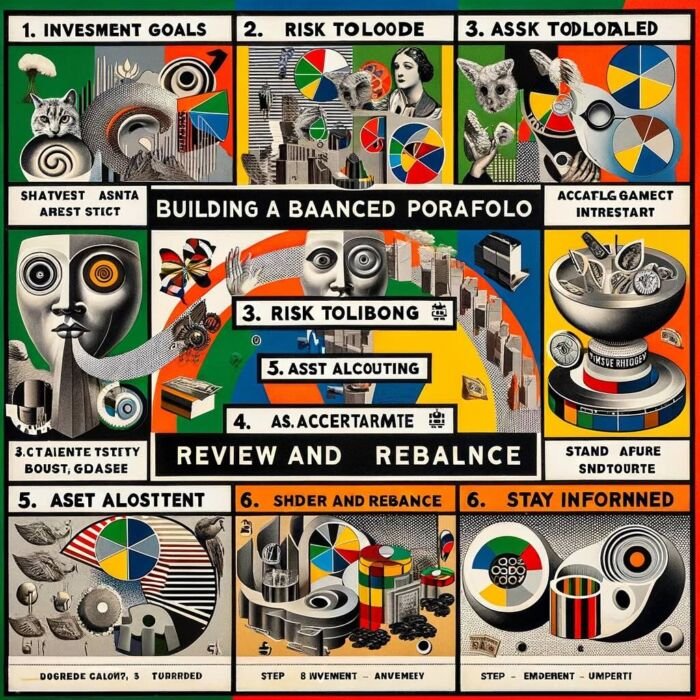Welcome, future savvy investor, to a topic that has the power to change your financial life dramatically: the creation of a balanced investment portfolio. Now, we know those might seem like heavy words, but hold tight. We’re here to break it down for you in manageable, bite-sized pieces.
Firstly, let’s tackle an essential question – why should we care about a balanced investment portfolio? Well, imagine setting sail on a vast ocean, a map in your hand, but no compass to guide your path. Investing without a balanced portfolio is quite similar. It’s like braving the financial storms without the right tools to ensure you reach your destination. A well-constructed, balanced investment portfolio not only helps to navigate these sometimes unpredictable financial waters, but it also provides a stable platform to grow your wealth consistently.

Creating a balanced portfolio is akin to crafting a well-rounded meal. Just as you need the right mix of protein, carbohydrates, and veggies, in investing, you require the right mix of asset classes like stocks, bonds, real estate, and more. Each ingredient plays a unique role, blending flavors and providing the nutrition your body needs. Likewise, different investments offer varying levels of risk and return, and together, they work towards nourishing your financial health.

Importance of having a balanced investment portfolio
So, what are we aiming for in this guide? Our mission is simple: to guide you step-by-step through the process of creating and maintaining a balanced portfolio that aligns with your financial goals and risk tolerance. This is not a ‘get-rich-quick’ scheme; rather, it’s about building solid, reliable strategies that pave the way to long-term financial success.
However, we must remember that every investor is unique – with different tastes, preferences, and risk appetites. Therefore, this guide is not a one-size-fits-all solution, but a roadmap to help you design your personalized investment portfolio. So, whether you’re a seasoned investor looking to fine-tune your portfolio or a beginner preparing for your maiden voyage into the world of investing, this guide promises to provide valuable insights and actionable tips.
Now, with all the ground rules set, let’s roll up our sleeves and dive into the nuts and bolts of building a balanced investment portfolio. Get ready to embark on a transformative journey towards financial empowerment. Buckle up and enjoy the ride!

Understanding Basic Investment Concepts
The world of investing, much like any other profession or hobby, has its own unique lingo. If you’re new to investing, these terms may sound like an entirely different language. But don’t worry, we’re here to be your interpreter and guide you through the language of finance. Let’s start with some of the key phrases you need to become familiar with on your investment journey.

Key Investment Terminology
- Diversification: Picture a juggler at a circus, effortlessly keeping multiple balls in the air. Now, imagine if one ball slips; the show still goes on because there are others in motion. Diversification in investing works similarly. It’s the strategy of spreading your investments across various asset classes, industries, and geographical regions, thus preventing your financial future from relying too heavily on a single investment. It’s the old wisdom of not putting all your eggs in one basket, applied to your finances.
- Asset Allocation: Think of this as the recipe for your investment meal. Just as a recipe dictates how much of each ingredient you need, asset allocation refers to the proportion of your portfolio invested in different asset classes (like stocks, bonds, real estate, and more). Your asset allocation is largely determined by your financial goals, risk tolerance, and investment horizon, and it’s a crucial component in defining the risk and return profile of your portfolio.
- Risk Tolerance: This is a measure of how much uncertainty you can handle in your investment returns. Are you someone who can ride out the stormy seas of the stock market without batting an eyelid, or does the mere thought of market volatility keep you up at night? Your risk tolerance could range from conservative (low tolerance for risk) to aggressive (high tolerance for risk), and it’s a key factor that shapes your investment strategy.

The Concept of Risk and Return
Now that we’ve gone over the terminology let’s tackle one of the fundamental principles of investing: the relationship between risk and return. Think of it as the yin and yang of finance. In essence, risk refers to the chance that an investment’s actual return will differ from the expected return. This includes the possibility of losing some or all of your initial investment.
On the flip side, return is the money you make on an investment. It could come in various forms – from capital appreciation (selling an investment for more than you paid) to income generated from the investment (like dividends or interest).
There’s an old saying in the investing world: “No risk, no reward.” Essentially, higher potential returns often come with a higher level of risk. It’s a trade-off. A low-risk investment like a government bond may promise steadier returns, but the potential for growth may not be as high as investing in something riskier like stocks. Understanding this interplay between risk and return is vital when making investment decisions.
The Importance of Time Horizon in Investing
Finally, let’s talk about the time horizon. It’s not a term out of a science fiction novel, but the expected time frame you plan to hold an investment before you need to access the funds. The time horizon plays a crucial role in determining both your risk tolerance and asset allocation.
For instance, if you’re saving for a down payment on a house you plan to buy in two years, you have a short-term time horizon. This might necessitate a more conservative investment approach, focusing more on preserving capital rather than aggressive growth. On the other hand, if you’re in your 20s and saving for retirement, you have a long-term time horizon. You might afford to take on more risk for the possibility of higher returns over the decades.
The bottom line? Understand your time horizon. It will guide you in choosing suitable investments and help you stick to your financial plan, even when market conditions get a bit choppy.
We’ve covered a lot of ground here, but don’t fret if you don’t have it all down just yet. Consider these the ABCs of investing; the foundation on which we’ll build as we delve deeper into the journey of creating a balanced portfolio. Take your time, re-read if needed, and when you’re ready, we’ll move onto understanding your unique investor profile.
source: The Money Guy Show on YouTube

Determining Your Investment Goals and Risk Tolerance
At this stage, you might be wondering, “Where do I start with this grand plan of building my investment portfolio?” Well, the answer lies within you. Yes, you read that right! Your unique financial goals and risk tolerance level are the bedrock on which your investment portfolio should be built. So, let’s explore these crucial starting points.
Setting Clear and Measurable Investment Goals
Imagine going on a road trip with no destination in mind. While it may sound adventurous, chances are you’ll end up lost, frustrated, or wasting resources. Similarly, investing without a clear purpose is like shooting arrows in the dark.
So, the first step in your investment journey is to define your investment goals. They should be as specific as possible. Instead of saying, “I want to be wealthy,” try something like, “I want to accumulate $500,000 for retirement in 30 years.” This provides a clear target for your investing efforts.
Your goals could be short-term (a vacation next year), medium-term (a down payment for a house in five years), or long-term (retirement in 20 or 30 years). Having a clear view of your goals not only helps you choose the right investments but also keeps you motivated during the inevitable ups and downs of the market.
Remember, each goal might require a different investment strategy. For instance, your retirement fund could be more aggressively invested in stocks for higher long-term returns, while your vacation fund might be kept in safer, less volatile assets.

Understanding Your Risk Tolerance
Knowing your risk tolerance is like understanding your personality – it’s what makes you, well, you. It’s about knowing how much investment risk you’re comfortable with. And it’s not just about your financial capacity to withstand losses (though that’s important), but also your emotional ability to handle the stress that can come with market downturns.
Why is this so important? Simply put, if you take on more risk than you can handle, you might panic and make hasty decisions during market slumps – like selling off when prices are low, exactly the opposite of what seasoned investors would do.
It’s crucial to remember that there’s no ‘right’ level of risk tolerance. Some people are thrill-seekers, both in life and in investing, while others prefer a quieter, steadier path. Both approaches can lead to success, given the right strategies.
Assessing Your Risk Tolerance
Now comes the tricky part – how do you quantify your risk tolerance? While it might seem like a vague concept, there are actually practical ways to gauge this.
One of the most effective methods is through a risk tolerance questionnaire. These questionnaires assess factors like your financial situation, investment goals, and how you’ve reacted to financial losses in the past to give you a rough measure of your risk tolerance.
You can find a variety of these questionnaires online. The Vanguard Investor Questionnaire is one widely used tool that provides a good starting point. Remember, these are just tools to guide you; they might not capture all the nuances of your individual situation. For a more personalized assessment, consider consulting with a financial advisor.
Investing is a journey full of exciting opportunities and challenges. Knowing your financial destination and understanding how much risk you can stomach is key to navigating this journey successfully. As we move forward, we’ll learn how to translate these personal factors into a concrete investment plan. So grab a cup of coffee, a notebook, and let’s move on to the next chapter of our investment journey.
source: Smart Investing Trends on YouTube

Introduction to Different Asset Classes
Alright, future investing maestro, it’s time to get acquainted with the instruments that will play the symphony of your financial growth – the asset classes. Picture yourself as the conductor of an orchestra, with each instrument (or asset class) playing its unique part to create a harmonious, beautiful melody (a balanced portfolio). Let’s dive in and understand what these different instruments are and the tunes they play.
Common Asset Classes
- Stocks: These represent a share in the ownership of a company. Buying a company’s stock means you’re buying a piece of the business and therefore have a claim on its future earnings. Think of it as being part-owner of a huge multinational corporation, right from the comfort of your home!
- Bonds: Bonds are essentially IOUs issued by entities like governments or corporations. When you buy a bond, you’re lending your money to the issuer for a fixed period of time. In return, they promise to pay you interest at regular intervals and to return the principal when the bond “matures,” or comes due.
- Cash and cash equivalents: This includes physical money, money in savings accounts, and short-term, highly secure investments like Treasury bills. Not as glamorous as owning stocks or bonds, but they play an important part in the orchestra.
- Real Estate: This encompasses properties, whether residential (like houses and condos) or commercial (like office buildings and malls). It could also include real estate investment trusts (REITs), which allow you to invest in property without the need to own physical real estate.
- Commodities: These are physical goods like gold, oil, natural gas, agricultural products, and more. Investing in commodities allows you to own a piece of these fundamental economic goods.

Risks and Returns Associated with Each Asset Class
- Stocks: Historically, stocks have offered high potential returns, but with a catch – they’re also more volatile and carry a higher risk than most other asset classes. While you could make handsome profits, you could also experience significant losses.
- Bonds: Considered less risky than stocks, bonds provide regular income through interest payments. However, their return potential is generally lower than that of stocks.
- Cash and cash equivalents: These are the safest assets, ideal for preserving capital and liquidity, but they offer the lowest return potential.
- Real Estate: Real estate can provide a good rate of return through both rental income and property appreciation. But it also carries risks like property market downturns, vacancies, or costly repairs.
- Commodities: Commodities can be volatile and their prices are influenced by global economic and political events. However, they can serve as a hedge against inflation and add diversification to a portfolio.
Role of Each Asset Class in a Balanced Portfolio
Just as an orchestra needs a blend of instruments to create a rich melody, a balanced portfolio requires a mix of asset classes, each playing its unique role:
- Stocks: These are the growth engine of your portfolio, offering the potential for high returns.
- Bonds: They provide stability and regular income, acting as a cushion during stock market downturns.
- Cash and cash equivalents: They offer liquidity and are a safe haven during market volatility.
- Real Estate: A good source of diversification, offering potential income and growth.
- Commodities: They add further diversification and can act as a hedge against inflation.
Remember, the proportion you allocate to each asset class should be based on your investment goals, risk tolerance, and time horizon. Like a skillful conductor, you should aim to create a beautiful harmony among these different asset classes that aligns with your unique financial symphony.
With these basics down, we’re ready to move onto the nitty-gritty of actually creating your balanced portfolio. Onwards and upwards, dear reader! Let’s tune our instruments and get ready to play.
source: Tae Kim – Financial Tortoise on YouTube

Asset Allocation: Creating the Right Mix
Now that we’ve met the band members of your investment orchestra, it’s time to give them their specific parts. And the musical score that outlines who plays when and how loud is known as ‘asset allocation’ in the world of investing.
The Importance of Asset Allocation
Asset allocation is the grand strategy of your portfolio. It’s the decision of how much of your portfolio you allocate to different asset classes—stocks, bonds, real estate, cash, and commodities.
Why is this so crucial? Well, research suggests that the majority of a portfolio’s return variability over time is determined by asset allocation. In other words, the choice of what percentage of your portfolio you invest in stocks versus bonds versus other assets has a greater impact on your portfolio’s performance than the specific stocks or bonds you pick. It’s like choosing the proportion of ingredients in a recipe before worrying about the specific brand of those ingredients.
Asset allocation is your primary tool for balancing risk and reward in your portfolio according to your specific financial goals and risk tolerance.
Allocating Assets Based on Risk Tolerance, Investment Goals, and Time Horizon
So, how do you decide on your asset allocation? Remember those personal factors we talked about earlier—your risk tolerance, investment goals, and time horizon? They play a crucial role here.
- Risk Tolerance: If you’re risk-averse, you might lean more towards bonds and cash, which are typically less volatile than stocks. On the other hand, if you can stomach more ups and downs in pursuit of higher returns, you might allocate more to stocks.
- Investment Goals: If your goal is to grow your wealth over the long term, you might focus more on stocks, which have historically had higher returns over the long run. If you’re focused on generating income, you might allocate more to bonds, which pay interest regularly.
- Time Horizon: If your goals are many years away, you might be able to ride out the short-term volatility of stocks for the promise of higher long-term returns. But if your goals are closer, you might want to focus more on preserving your wealth with safer investments like bonds or cash.
Remember, there’s no one-size-fits-all formula for asset allocation. It’s a deeply personal decision based on your unique circumstances.

Strategic vs. Tactical Asset Allocation
Asset allocation strategies can broadly be divided into two types: strategic and tactical.
- Strategic Asset Allocation: This involves setting your target asset allocation based on your long-term financial goals and risk tolerance, and then largely sticking to it over the long run, regardless of short-term market fluctuations. Regular rebalancing is used to bring your portfolio back to its target allocations.
- Tactical Asset Allocation: This is a more active approach, where you temporarily deviate from your strategic asset allocation to take advantage of investment opportunities presented by market conditions. It requires a good understanding of the markets and investment principles, as well as the discipline to revert back to your strategic allocation when the timing play has run its course.
The choice between strategic and tactical asset allocation depends on your investment knowledge, time commitment, and risk tolerance.
Creating the right mix of assets in your portfolio is part art, part science. It’s about blending different ingredients together to create a flavorful stew that suits your palate. With the right allocation, you can create a portfolio that fits your risk tolerance, helps you achieve your investment goals, and allows you to sleep peacefully at night, regardless of what’s happening in the markets.
As you evolve and grow as an investor, you’ll find that asset allocation is not a one-time decision, but a dynamic process that changes with your life circumstances. So get ready to embrace the journey, because it’s time to start mixing!
source: Fidelity Investments on YouTube

Diversification: Spreading the Risks
The stage is set. You’ve met your band, handed out the musical scores, but before the curtains rise and the concert begins, there’s one last thing to consider. It’s a strategy that can make your financial symphony more resilient and harmonious, and it’s called ‘diversification’.
The Concept of Diversification
Diversification is like the proverbial advice, “Don’t put all your eggs in one basket”. In the world of investing, it means spreading your money across different investments within each asset class. So, instead of buying shares in just one company, you buy shares in several different companies across different industries. Similarly, you’d buy bonds from different issuers, invest in real estate properties in different locations, and so on.
Why would you want to do this? Well, just as variety is the spice of life, diversification is the spice of investing. It adds flavor to your portfolio and reduces the risk of any single investment dominating your returns.

The Role of Diversification in Reducing Risk
Think of diversification as your portfolio’s superhero, protecting you from the villainous ‘Risk.
Here’s the magic of diversification: Different types of investments often perform differently under the same market conditions. While one investment may be down, another might be up. By holding a mix of investments, you’re aiming to smooth out the inevitable ups and downs of the market. Even if one stock tanks, you’ve got plenty of others that could help counterbalance the loss.
Remember, while diversification can help reduce risk, it doesn’t eliminate it entirely. It’s not a guarantee against loss, but a powerful tool to manage the level of risk you’re comfortable with.
Tips for Achieving Effective Diversification
Ready to diversify? Here are a few strategies to get you started:
- Spread Your Investments: Don’t just invest in one company or one sector. Spread your investments across different companies, sectors, and even geographical locations.
- Use Mutual Funds and ETFs: These are a simple and effective way to achieve diversification. They pool money from many investors to invest in a large number of securities. You can find mutual funds and ETFs focused on almost every part of the market.
- Consider Your Entire Portfolio: When diversifying, look at your entire portfolio, not just individual investments. Even if one particular stock looks risky, it might be a good fit if it behaves differently than the rest of your portfolio.
- Regularly Review and Rebalance: Over time, some investments may grow faster than others, shifting your portfolio away from your original plan. Regularly review your portfolio and rebalance if necessary to maintain your desired level of diversification.
With diversification, you’re not trying to hit the jackpot with a single investment but aiming for consistent returns that help you achieve your long-term financial goals. It’s like cooking a well-balanced meal – a dash of this, a pinch of that, making sure no single ingredient overpowers the others. Diversification is the secret sauce that, when done right, can help create a portfolio that’s palatable for your risk appetite and deliciously suited for your financial goals.

Choosing Investment Vehicles
Bravo! We’ve discussed the big-picture strategies for building a balanced portfolio, like setting goals, determining asset allocation, and diversifying. Now it’s time to zoom in and examine the tools we use to put these strategies into practice: the investment vehicles. Think of them as the individual notes that make up the beautiful symphony of your financial portfolio. Let’s explore them.
Different Investment Vehicles
- Individual Stocks: Buying shares of a company makes you a part-owner. It’s exciting, isn’t it? You get to participate in the company’s growth and potentially receive dividends, which are a portion of the company’s profits paid out to shareholders.
- Bonds: When you purchase a bond, you’re lending money to the issuer—be it a government or a corporation—for a fixed period of time. They promise to pay you a fixed interest rate and return your principal when the bond matures.
- Exchange-Traded Funds (ETFs): ETFs are like a basket of securities—they can hold hundreds or even thousands of stocks or bonds. They trade on an exchange, just like individual stocks, which means you can buy and sell them throughout the day at fluctuating prices.
- Mutual Funds: Similar to ETFs, mutual funds pool money from many investors to invest in a diversified portfolio of stocks, bonds, or other assets. However, unlike ETFs, mutual fund shares are bought and sold at their net asset value at the end of the trading day.

Pros and Cons of Each Type of Investment Vehicle
- Individual Stocks:
- Pros: High growth potential; you can focus on specific companies you believe in; potential for dividends.
- Cons: High risk; requires a lot of research and ongoing management; lack of diversification when not handled properly.
- Bonds:
- Pros: Regular income through interest payments; lower risk compared to stocks; can be a safe haven during market turbulence.
- Cons: Lower return potential; interest rate and credit risk.
- ETFs:
- Pros: Instant diversification; flexibility to buy and sell at intraday market prices; usually have lower expense ratios than mutual funds.
- Cons: Price fluctuations throughout the day can be a disadvantage for inexperienced investors; potential for trading costs.
- Mutual Funds:
- Pros: Diversification; professional management of the fund; suitable for automatic investment and reinvestment.
- Cons: Typically have higher fees than ETFs; can only be bought or sold at the end of the trading day.
Choosing between these investment vehicles often comes down to your personal circumstances and preferences. Do you enjoy researching companies and have the time for it? Perhaps individual stocks could be for you. Want a “set it and forget it” option? Mutual funds or ETFs might be a better fit. Just remember, it’s not about picking the perfect note—it’s about how those notes work together to create a harmonious melody for your financial future. Stay tuned as we move towards the grand finale of our investment symphony: portfolio review and rebalancing.
source: Toby Newbatt on YouTube

Building Your Portfolio: Step-by-Step Process
By now, you’ve journeyed through the conceptual forest of investing and navigated through the thickets of terminology, theory, and tactics. The result? You’re standing at the edge of a beautiful vista with all the tools you need to build your own balanced investment portfolio. So, let’s roll up our sleeves, don the financial hard hats, and build the financial future you’ve envisioned!
Step 1: Set Your Investment Goals
Begin by asking yourself: Why am I investing? Are you saving for retirement? Do you want to buy a home or pay for a child’s education? Maybe you’re aiming for financial independence? The clearer your goals, the better you can tailor your investment portfolio to meet them. It’s like deciding on the destination before setting out on a journey. So, grab a pen and paper, find a quiet place, and jot down your goals—both short-term and long-term.
Step 2: Assess Your Risk Tolerance
Your risk tolerance is your ability and willingness to lose some or all of your original investment in exchange for greater potential returns. Some people are thrill-seekers, comfortable riding the roller-coaster of the stock market. Others prefer a steadier, safer ride. Neither approach is ‘right’ or ‘wrong’. It’s all about what works for you. So, conduct a genuine self-assessment or use a reliable online questionnaire to understand your risk tolerance.
Step 3: Decide on Your Asset Allocation
Based on your goals and risk tolerance, decide how much of your portfolio to dedicate to different asset classes. Do you want a more aggressive portfolio skewed towards stocks, or a more conservative one with a larger share of bonds? Maybe a mix of both? Remember the ‘Goldilocks’ principle—not too hot, not too cold, but just right. Your asset allocation should fit your financial goals like a well-tailored suit.
Step 4: Choose the Right Investment Vehicles
Now comes the exciting part—choosing the specific investments to include in your portfolio. This could be individual stocks or bonds, ETFs, mutual funds, or a mix. Remember, each investment vehicle has its strengths and weaknesses, so choose the ones that align with your risk tolerance, time horizon, and investing skills. It’s like picking the right tools for a job—you need the right ones to get the work done effectively.
Step 5: Implement Your Plan and Purchase Investments
With a plan in hand and tools in your belt, it’s time to lay the first brick of your financial edifice by actually purchasing your chosen investments. You can do this through an online brokerage account or through your bank. When you click that ‘buy’ button, remember, you’re not just buying a piece of paper or a digital entry. You’re buying a piece of a business, a share of a bond, or a sliver of a vast mutual fund or ETF. You’re setting a course towards your financial future. So, take a deep breath, click that button, and welcome aboard the investment train!
Creating a balanced investment portfolio is not a one-and-done task. It’s a living, breathing entity that needs ongoing care and attention, which brings us to our final piece of the puzzle: portfolio review and rebalancing.
source: Learn to Invest – Investors Grow on YouTube

Monitoring and Rebalancing Your Portfolio
The investment symphony has begun, but even the most beautifully composed music can go off tune without the right attention and adjustment. The same applies to your investment portfolio. It’s an ongoing journey and requires regular check-ins and tweaks, a process known as monitoring and rebalancing. It’s like a master gardener tending their garden, nurturing what’s thriving, pruning what’s not, and always ensuring the garden maintains its balance and harmony.
The Importance of Regularly Reviewing Your Portfolio
Regular portfolio reviews are crucial for several reasons. For one, the financial markets aren’t static—they’re dynamic, fluctuating entities. As the markets change, so too can the value of your investments. A stock that was just 5% of your portfolio could grow to become 10%, or a sector that was thriving might take a hit.
Furthermore, your goals or risk tolerance might change. You might get a new job with a higher salary, have a child, or find that as you age, you’re not quite as comfortable with risk as you once were.
Regular reviews—whether quarterly, semi-annually, or annually—help ensure that your portfolio stays aligned with your goals, risk tolerance, and the market’s ever-changing landscape.

How and When to Rebalance Your Portfolio
Rebalancing is like recalibrating your portfolio’s GPS—it helps you get back on track towards your financial destination.
Here’s a simple approach to rebalancing. First, take a look at your current asset allocation and compare it to your original plan. Let’s say you initially aimed for a 60% stocks and 40% bonds mix. If due to some stellar stock performance, your portfolio is now 70% stocks and 30% bonds, it’s time to rebalance. You might sell some stocks or buy more bonds to return to your original 60/40 split.
But when should you rebalance? There are two common approaches:
- Time-Based Rebalancing: Rebalance your portfolio at fixed intervals, like once a year or once every six months.
- Threshold-Based Rebalancing: Rebalance when an asset class shifts a certain percentage from your original allocation.
Rebalancing helps maintain your desired level of risk and keeps your portfolio tuned to your unique financial symphony.
Considerations in Case of Major Life Changes
Life is a journey with many twists and turns. Major life events—like marriage, divorce, having children, changing jobs, or retiring—can all affect your financial situation and goals. In these cases, it’s wise to revisit your investment plan.
For example, if you’re planning to retire soon, you might want to lower your portfolio’s risk level to preserve your capital. Or, if you’re expecting a baby, maybe you’d want to start an education fund.
Remember, your portfolio is a living entity, reflecting your life’s journey. It’s not set in stone, but rather a flexible, evolving roadmap that should adjust and adapt as your life and goals change.

Common Mistakes to Avoid When Building a Portfolio
We’ve journeyed together through the exciting world of investing, building a balanced portfolio brick by brick. But just as important as knowing what to do is knowing what not to do. Yes, even in the symphony of investing, there are a few discordant notes that can throw your performance off track. Let’s explore some of these common investment missteps and, more importantly, how to sidestep them.

Frequent Investment Mistakes
- Trying to Time the Market: Many investors, both novice and seasoned, fall into the trap of trying to buy low and sell high based on market predictions. But even the savviest Wall Street wizards often get it wrong. The market is a complex, unpredictable creature, and trying to time it can lead to stress and poor decision-making.
- Lack of Diversification: Putting all your eggs in one basket, or a few baskets, exposes you to unnecessary risk. If a single investment or sector tanks, it could significantly impact your portfolio.
- Ignoring Costs: Overlooking the costs associated with investing—such as transaction fees, fund expense ratios, or tax implications—can eat into your returns over time.
- Emotional Investing: It’s human nature to be led by our emotions, but investing should be a rational process. Decisions driven by fear or greed can lead to buying high, selling low, and other financially detrimental moves.
Strategies to Avoid These Mistakes
- Stay the Course: Instead of trying to time the market, adopt a long-term, patient approach. Keep your focus on your goals, stick to your plan, and resist the urge to react to short-term market fluctuations.
- Diversify, Diversify, Diversify: Spread your investments across various asset classes, sectors, and geographical regions to minimize risk. Remember, a well-diversified portfolio is like a sturdy ship that can weather various market storms.
- Be Cost-Conscious: Choose investment vehicles with low fees where possible, and always be aware of potential tax implications. Like a slow leak in a boat, even small fees can cause significant damage over time.
- Keep Emotions in Check: Treat investing like a business—base your decisions on solid research, not feelings. If market turbulence makes you anxious, remind yourself that volatility is part of the investing journey.
Investing is a bit like navigating a winding road. There will be ups and downs, unexpected turns, and perhaps a few potholes. But with careful planning, patience, and the right approach, you can avoid common pitfalls and stay on track towards your financial destination. Remember, the goal isn’t to have a perfect journey—it’s to enjoy the ride and reach your destination with a richer, more balanced portfolio.
source: Financial Knowledge on YouTube

12 Frequently Asked Questions About Building a Balanced Investment Portfolio for Long-Term Success
What exactly is a balanced investment portfolio?
A balanced investment portfolio is a mix of different asset classes—such as stocks, bonds, real estate, cash, and sometimes commodities—structured to balance risk and reward. Its purpose is to provide growth potential while offering stability through diversification, making it suitable for long-term financial goals.
Why is asset allocation so important in building a portfolio?
Asset allocation determines the proportion of your investments in each asset class, and research shows this has a greater impact on long-term performance than individual stock picking. It allows investors to align their portfolio’s risk and return characteristics with their specific goals and risk tolerance.
How do I determine my ideal asset allocation?
Your asset allocation should reflect your risk tolerance, investment goals, and time horizon. Generally, longer time horizons and higher risk tolerance allow for more equities, while shorter time horizons and lower risk tolerance often favor bonds and cash equivalents. Many investors use a 60/40 mix (stocks/bonds) as a starting point, then adjust from there.
What’s the difference between diversification and asset allocation?
Asset allocation is about how much of each asset class you hold, while diversification is about spreading your investments within those classes—like holding multiple stocks across industries rather than just one. Together, they reduce portfolio risk and smooth returns over time.
How often should I review and rebalance my portfolio?
A good rule of thumb is to review your portfolio at least once a year—or sooner if you experience major life changes. Rebalancing ensures your asset mix stays aligned with your goals. You can do this on a time-based schedule (e.g., annually) or threshold-based (e.g., if any asset class drifts 5% or more from target).
Should beginners use ETFs or individual stocks to build their portfolios?
For most beginners, ETFs and mutual funds are ideal because they offer instant diversification, professional management, and lower time commitments. Individual stocks require more research and monitoring, which can be challenging without experience.
How does risk tolerance affect portfolio construction?
Risk tolerance determines how much volatility and potential loss you can handle. Investors with high risk tolerance can include more equities to pursue higher returns, while conservative investors may prefer a larger allocation to bonds and cash to minimize fluctuations.
Is it possible to build a balanced portfolio with a small amount of money?
Yes, absolutely. Many brokers now offer fractional shares, allowing you to buy portions of ETFs and stocks. With as little as $100, you can build a well-diversified ETF-based portfolio, avoiding the need to purchase expensive individual shares.
What role do real estate and commodities play in a balanced portfolio?
Real estate adds diversification, potential income, and inflation protection. Commodities can hedge against inflation and bring uncorrelated returns. While not essential for everyone, including a small percentage (e.g., 5–10%) of these assets can improve portfolio resilience.
How do I adjust my portfolio as I get closer to retirement?
As retirement approaches, it’s common to reduce exposure to volatile assets like stocks and increase allocations to bonds and cash equivalents to preserve capital. This “glide path” strategy helps protect your savings from market downturns when you’re closer to needing the funds.
What are some common mistakes to avoid when building a portfolio?
Typical pitfalls include trying to time the market, failing to diversify, ignoring costs, and letting emotions dictate decisions. A disciplined, long-term approach—focused on goals and strategy rather than short-term noise—helps avoid these errors.
Can I manage my own balanced portfolio, or should I hire a financial advisor?
Many investors successfully manage their own portfolios using index funds or ETFs, especially with automated tools. However, if your situation is complex or you prefer guidance, a fee-only fiduciary financial advisor can provide tailored advice without product sales conflicts.
Conclusion: Balancing An Investment Portfolio
There you have it! We’ve explored the winding paths and tall peaks of the investing landscape together. Like intrepid explorers, we’ve uncovered the secrets of creating a balanced investment portfolio, and along the way, we’ve dug up some treasure—knowledge that you can use to chart your financial future.
Let’s revisit the footprints of our journey:
- We started by understanding the importance of a balanced portfolio and learning the basics of investing, from key terms to concepts such as risk, return, and time horizon.
- We then assessed our investment goals and risk tolerance, like mapping out our destination before setting off.
- We explored the exciting world of different asset classes, getting to know their unique characteristics and roles in our portfolio.
- Then, we learned about asset allocation, or how to create a unique blend of assets that suits our individual financial goals and risk tolerance.
- Diversification came next, showing us how to spread the risks and increase our chances of success.
- We dived into the pool of different investment vehicles, understanding their pros and cons.
- Armed with knowledge and tools, we went through the step-by-step process of building our own portfolio.
- We also discussed how to monitor and rebalance our portfolio, and adapt it to major life changes.
- And finally, we learned about common investing pitfalls and how to avoid them.
As we stand at the end of this journey, remember that the path to financial success is not a sprint—it’s a marathon. It requires patience, discipline, and a well-balanced, diversified portfolio attuned to your personal goals and risk tolerance.
So, whether you’re a seasoned investor or a novice standing at the starting line, know that it’s never too early or too late to start or refine your investment journey. As the famous Chinese proverb goes, “The best time to plant a tree was 20 years ago. The second best time is now.”
Investing is more than just numbers on a screen. It’s a powerful tool that can help you build a better future, achieve your dreams, and find financial freedom. So, continue to learn, stay curious, and remember—the journey of investing is just as rewarding as the destination.
Here’s to your financial symphony. May it play the sweetest tunes of success, prosperity, and peace of mind for you. Happy investing!
Important Information
Comprehensive Investment Disclaimer:
All content provided on this website (including but not limited to portfolio ideas, fund analyses, investment strategies, commentary on market conditions, and discussions regarding leverage) is strictly for educational, informational, and illustrative purposes only. The information does not constitute financial, investment, tax, accounting, or legal advice. Opinions, strategies, and ideas presented herein represent personal perspectives, are based on independent research and publicly available information, and do not necessarily reflect the views or official positions of any third-party organizations, institutions, or affiliates.
Investing in financial markets inherently carries substantial risks, including but not limited to market volatility, economic uncertainties, geopolitical developments, and liquidity risks. You must be fully aware that there is always the potential for partial or total loss of your principal investment. Additionally, the use of leverage or leveraged financial products significantly increases risk exposure by amplifying both potential gains and potential losses, and thus is not appropriate or advisable for all investors. Using leverage may result in losing more than your initial invested capital, incurring margin calls, experiencing substantial interest costs, or suffering severe financial distress.
Past performance indicators, including historical data, backtesting results, and hypothetical scenarios, should never be viewed as guarantees or reliable predictions of future performance. Any examples provided are purely hypothetical and intended only for illustration purposes. Performance benchmarks, such as market indexes mentioned on this site, are theoretical and are not directly investable. While diligent efforts are made to provide accurate and current information, “Picture Perfect Portfolios” does not warrant, represent, or guarantee the accuracy, completeness, or timeliness of any information provided. Errors, inaccuracies, or outdated information may exist.
Users of this website are strongly encouraged to independently verify all information, conduct comprehensive research and due diligence, and engage with qualified financial, investment, tax, or legal professionals before making any investment or financial decisions. The responsibility for making informed investment decisions rests entirely with the individual. “Picture Perfect Portfolios” explicitly disclaims all liability for any direct, indirect, incidental, special, consequential, or other losses or damages incurred, financial or otherwise, arising out of reliance upon, or use of, any content or information presented on this website.
By accessing, reading, and utilizing the content on this website, you expressly acknowledge, understand, accept, and agree to abide by these terms and conditions. Please consult the full and detailed disclaimer available elsewhere on this website for further clarification and additional important disclosures. Read the complete disclaimer here.





